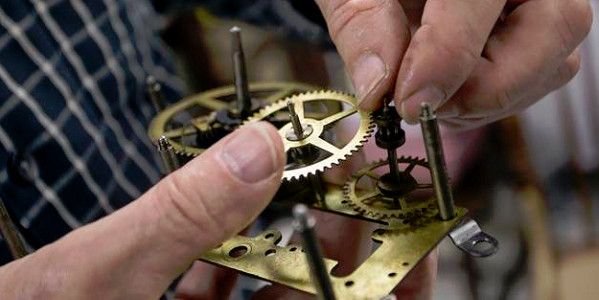Clock repair has a long and fascinating history, evolving from rudimentary methods to sophisticated techniques. This evolution mirrors advancements in technology and craftsmanship. Here’s a look at how clock repair techniques have changed over time, highlighting key developments that have shaped the field.
1. Early Clock Repair Techniques
In the early days, clock repair was a matter of basic mechanical adjustments. Ancient clocks, such as water clocks and sundials, did not require repair in the modern sense. However, by the medieval period, mechanical clocks began to emerge, leading to the need for more structured repair methods.
- Initial Repairs: Early clockmakers would perform repairs using simple tools like screwdrivers and pliers. They would manually adjust gears and springs to fix timekeeping issues.
- Craftsmanship: Clock repair relied heavily on the skills of the clockmaker, who often had to fabricate replacement parts from scratch.
As clock technology advanced, so did repair techniques, leading to more refined methods.
2. The Advent of Precision Tools
The 17th and 18th centuries saw significant advancements in clock design and repair. The introduction of more intricate mechanical movements necessitated the development of precision tools and techniques.
- Introduction of Specialized Tools: The use of precision tools like pin vises and fine screwdrivers allowed clockmakers to perform more detailed repairs.
- Refinement of Techniques: Techniques such as “banking” and “restoring” emerged, focusing on adjusting the escapement and ensuring the clock’s accuracy.
Transitioning into the 19th century, clock repair continued to evolve with industrialization.
3. Industrial Revolution and Clock Repair
The Industrial Revolution brought mass production, which changed clock repair dramatically. With clocks becoming more widely available, repair techniques had to adapt to handle a larger volume and variety of timepieces.
- Mass Production: Standardized parts made it easier to replace damaged components. Clockmakers could use interchangeable parts, reducing the need for custom fabrication.
- Advancements in Training: Clock repair became more formalized, with the establishment of training programs and apprenticeships to teach new repair techniques.
In the 20th century, the rise of modern technology introduced even more changes.
4. Modern Innovations in Clock Repair
The 20th and 21st centuries have seen significant technological advancements in clock repair. Modern tools and techniques have greatly improved the precision and efficiency of repairs.
- Digital Tools: The advent of digital tools and machines, such as computerized lathes and 3D printers, has revolutionized clock repair. These tools allow for precise fabrication of parts and detailed diagnostics.
- Advanced Techniques: Techniques like ultrasonic cleaning and electronic testing have become standard. These methods help ensure that clocks are cleaned and calibrated with the utmost accuracy.
Transitioning to the future, clock repair continues to evolve with emerging technologies.

5. The Future of Clock Repair
The future of clock repair will likely see further integration of technology and traditional craftsmanship. Emerging technologies promise to enhance the precision and efficiency of repairs.
- Integration of AI: Artificial intelligence and machine learning may soon play a role in diagnosing and predicting clock issues, allowing for proactive maintenance.
- 3D Printing: Advances in 3D printing will likely enable more complex and customized repairs, potentially allowing clockmakers to recreate rare or intricate parts with ease.
Overall, the evolution of clock repair reflects broader trends in technology and craftsmanship. From simple mechanical adjustments to sophisticated digital tools, the field has continuously adapted to meet the needs of an ever-changing world.
Conclusion
The history of clock repair techniques is a testament to human ingenuity and technological advancement. Starting from basic mechanical adjustments, repair techniques have evolved through the introduction of precision tools, industrialization, and modern innovations. As we look to the future, continued advancements in technology will likely further transform the art and science of clock repair, ensuring that these timeless instruments remain both functional and cherished.





Yo, tried some spins on sg77slot. Got a couple small wins, nothing crazy. Site’s easy to navigate though, which is a plus. Check them out: sg77slot
I’m all about bong88keonhacai. Good odds and smooth experience, gotta love it
Martin Scorseses Abgesang auf den trügerischen Glanz von Las Vegas ist nach wie
vor ein großartiges Erlebnis für die Sinne. Doch der Glanz perlt
ab, die Vertreibung aus dem Paradies ist unumgänglich, das Geld hat die Seelen vergiftet.
Der Soundtrack gleicht einer Hitparade, dehnt „Casino“ beinahe zu
einer einzigen Musikmontage und rhythmisiert das Geschehen so gekonnt, wie es in dieser formalen Brillanz nur ein Martin-Scorsese-Film bewerkstelligt.
Grandios agieren auch Golden-Globe-Preisträgerin Sharon Stone
(ausgezeichnet für ihre Leistung in „Casino“) und Oscar-Preisträger Joe Pesci („Good Fellas“,
1990). Das Schauspielertrio, angeführt vom Golden-Globe- und zweifachen Oscarpreisträger
(„Der Pate II“, 1974, „Wie ein wilder Stier“, 1990) Robert De Niro, liefert eine
atemberaubende Leistung. Mit seinem Drei-Stunden-Epos ist Martin Scorsese ein echter Klassiker gelungen. „Casino“ zählt zu den größten kommerziellen Erfolgen Scorseses.
Laut Rüdiger Suchsland (artechock.de) zeigt die Mafia einzigartig die dunklen Seiten vom
Kapitalismus, und verdient die Aufmerksamkeit von der Filmindustrie und Scorsese.
Das Mafia-Syndikat Chicago Outfit beauftragt ihn damit, den täglichen Hotel-
und Casinobetrieb im Tangiers Spielcasino von Las Vegas zu leiten. Die Handlung im
Film „Casino“ erzählt die Geschichte der Mafia, die den Spieler Sam „Ace“
Rothstein (Robert De Niro) dazu bringt, ein Spielcasino in Las Vegas zu betreiben. „Casino“ ist ein Kriminalfilm-Drama aus dem Jahr 1995 vom Regiseur Martin Scorsese.
References:
https://online-spielhallen.de/bregenzer-casino-bonus-code-alle-wichtigen-infos/